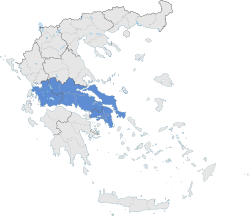Continental Greece
|
Continental / Central Greece Στερεά / Κεντρική Ελλάδα (Στερεά Ελλάδα) |
|
|---|---|
| Traditional region of Greece | |
 Continental Greece (blue) within Greece |
|
| Capital | Athens |
| Subdivisions | |
| Area | |
| • Total | 24,818.3 km2 (9,582.4 sq mi) |
| Population | |
| • Total | 4,591,568 (2,001 census) |
| • Density | 185/km2 (480/sq mi) |
| Demonym(s) | Stereoelladites, Roumeliotes |
Continental Greece (Greek: Στερεά Ελλάδα, Stereá Elláda; formerly Χέρσος Ἑλλάς, Chérsos Ellás), colloquially known as Roúmeli (Ρούμελη), is a traditional geographic region of Greece. In English the area is usually called Central Greece, but the equivalent Greek term (Κεντρική Ελλάδα, Kentrikí Elláda) is more rarely used.
Since 1987, its territory has been divided among the administrative regions of Central Greece and Attica, and the regional unit of Aetolia-Acarnania in the administrative region of West Greece.
The region has traditionally been known as Roúmeli (Ρούμελη), a name deriving from the Turkish word Rumelia or Rumeli, meaning "the land of the Rûm [the Romans, i.e. the Byzantine Greeks]" and originally encompassing all of the Ottoman Empire's European possessions. The official name Stereá Elláda ("Continental" or "Mainland" Greece), derives from the juxtaposition with the Peloponnese peninsula across the Corinthian Gulf, and the fact that these two territories formed the independent Greek state after the Greek War of Independence.
Central Greece is the most populous geographical region of Greece, with a population of 4,591,568 people, and covers an area of 24,818.3 km², making it the second largest of the country. It is located to the north of the Peloponnese and to the south of Thessaly and Epirus, bordering the Aegean Sea to the east, the Ionian Sea to the west and the Corinthian Gulf to the south. Its climate is temperate along its coastlines, and dry in the interior.
...
Wikipedia
